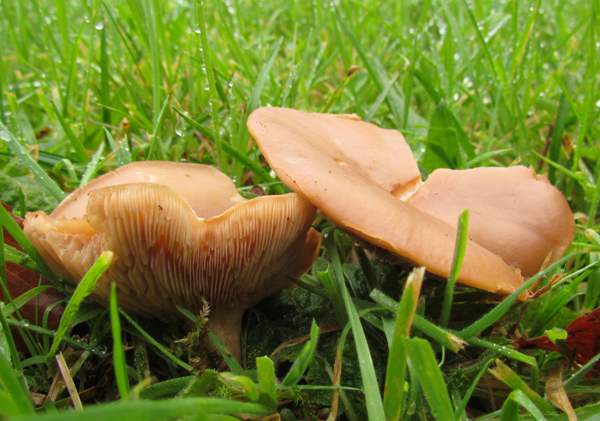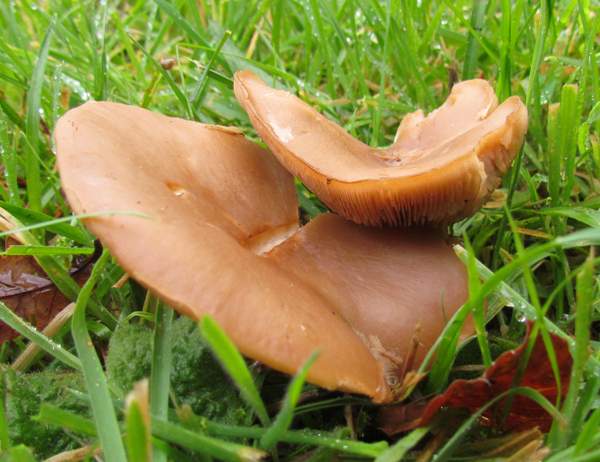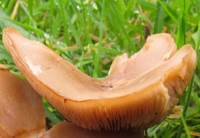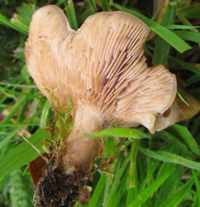Lepista multiformis (Romell) Gulden
Phylum: Basidiomycota - Class: Agaricomycetes - Order: Agaricales - Family: Tricholomataceae
Distribution - Taxonomic History - Etymology - Identification - Culinary Notes - Reference Sources

Lepista mutiformis is a rare grassland mushroom which is all too easily mistaken for a Field Blewit Lepista saeva.
Distribution
This member of the Lepista genus is very rare in Britain but rather more common in alpine regions of Europe and in Scandinavia. (The specimens shown here were found in coastal grassland at Ynyslas - Dyfi National Nature Reserve - in West Wales in October 2011.)

Taxonomic history
Originally described in 1911 by the Swedish mycologist Lars Romell (1854 - 1927), who gave it the binomial scientific name Tricholoma multiforme, this grassland mushroom was transferred to the genus Lepista in 1983 by Norwegian mycologist Gro Sissel Gulden (b. 1939), whereupon its scientific name became Lepista multiformis.
Tricholoma multiforme Romell is a synonym of Lepista multiformis.
Etymology
Lepista comes from Latin and means a wine pitcher or a goblet, and when fully mature the caps of Lepista species do usually become concave (sometimes referred to as being infundibuliform) like shallow chalices or goblets. Rather as it sounds, the specific epithet mutiformis simply means 'of many shapes or forms'.
Identification guide
 |
Cap4 to 12cm across, convex and later depressed often with a wavy margin; smooth all over or smooth with a slightly fibrilose region close to the margin; vinaceous brown to liver brown when wet, drying to a more pinkish brown or yellowish brown. |
 |
GillsDecurrent, crowded, whitish when very young, soon becoming pinkish brown when mature; often with reddish gill edges. Stem3.5 to 10cm long and 5 to 20mm diameter; fibrillose; tawny, but somewhat paler than the cap; no ring. |
SporesEllipsoidal, faintly warty, 6 -7.5 x 3.5-5μm. Spore printPale pink to pale clay. |
|
Odour/taste |
Slightly aromatic odour; pleasant, mild taste. |
Habitat & Ecological role |
In small tufts more often than singly, in all kinds of grassland including leaf-litter-rich roadside verges and other disturbed, grassy areas; sometimes producing fairy rings in lawns and parks. |
Season |
August to October in Britain. |
Similar species |
The Tawny Funnel Lepista flaccida occurs in woodland habitats. The Field Blewit Lepista saeva has a purple-flushed stem and usually a paler cap; it is also a grassland mushroom. |
Culinary Notes
Lepista multiformis is reportedly edible, but because of its scarcity in Britain it should not be collected.
Reference Sources
Fascinated by Fungi, 2nd Edition, Pat O'Reilly 2016, reprinted by Coch-y-bonddu Books in 2022.
Christensen, M. & Gulden, G. (2008). Lepista. – In: Knudsen, H. & Vesterholt, J. (eds.): Funga Nordica, 403, 405-409
Dictionary of the Fungi; Paul M. Kirk, Paul F. Cannon, David W. Minter and J. A. Stalpers; CABI, 2008
Taxonomic history and synonym information on these pages is drawn from many sources but in particular from the British Mycological Society's GB Checklist of Fungi.
Fascinated by Fungi. Back by popular demand, Pat O'Reilly's best-selling 450-page hardback book is available now. The latest second edition was republished with a sparkling new cover design in September 2022 by Coch-y-Bonddu Books. Full details and copies are available from the publisher's online bookshop...

